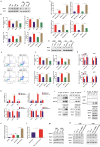Anoikis resistance and immune escape mediated by Epstein-Barr virus-encoded latent membrane protein 1-induced stabilization of PGC-1α promotes invasion and metastasis of nasopharyngeal carcinoma
- PMID: 37803433
- PMCID: PMC10559433
- DOI: 10.1186/s13046-023-02835-6
Anoikis resistance and immune escape mediated by Epstein-Barr virus-encoded latent membrane protein 1-induced stabilization of PGC-1α promotes invasion and metastasis of nasopharyngeal carcinoma
Abstract
Background: Epstein-Barr virus (EBV) is the first discovered human tumor virus that is associated with a variety of malignancies of both lymphoid and epithelial origin including nasopharyngeal carcinoma (NPC). The EBV-encoded latent membrane protein 1 (LMP1) has been well-defined as a potent oncogenic protein, which is intimately correlated with NPC pathogenesis. Anoikis is considered to be a physiological barrier to metastasis, and avoiding anoikis is a major hallmark of metastasis. However, the role of LMP1 in anoikis-resistance and metastasis of NPC has not been fully identified.
Methods: Trypan blue staining, colony formation assay, flow cytometry, and TUNEL staining, as well as the detection of apoptosis and anoikis resistance-related markers was applied to evaluate the anoikis-resistant capability of NPC cells cultured in ultra-low adhesion condition. Co-immunoprecipitation (Co-IP) experiment was performed to determine the interaction among LMP1, PRMT1 and PGC-1α. Ex vivo ubiquitination assay was used to detect the ubiquitination level of PGC-1α. Anoikis- resistant LMP1-positive NPC cell lines were established and applied for the xenograft and metastatic animal experiments.
Results: Our current findings reveal the role of LMP1-stabilized peroxisome proliferator activated receptor coactivator-1a (PGC-1α) in anoikis resistance and immune escape to support the invasion and metastasis of NPC. Mechanistically, LMP1 enhances PGC-1α protein stability by promoting the interaction between arginine methyltransferase 1 (PRMT1) and PGC-1α to elevate the methylation modification of PGC-1α, thus endowing NPC cells with anoikis-resistance. Meanwhile, PGC-1α mediates the immune escape induced by LMP1 by coactivating with STAT3 to transcriptionally up-regulate PD-L1 expression.
Conclusion: Our work provides insights into how virus-encoded proteins recruit and interact with host regulatory elements to facilitate the malignant progression of NPC. Therefore, targeting PGC-1α or PRMT1-PGC-1α interaction might be exploited for therapeutic gain for EBV-associated malignancies.
Keywords: Anoikis resistance; Immune escape; LMP1; Nasopharyngeal carcinoma; PGC-1α.
© 2023. Italian National Cancer Institute ‘Regina Elena’.
Conflict of interest statement
The authors declare that they have no competing interests.
Figures








Similar articles
-
Modified Anoikis Assay That Functionally Segregates Epstein-Barr Virus LMP1 Strains into Two Groups.J Virol. 2018 Aug 29;92(18):e00557-18. doi: 10.1128/JVI.00557-18. Print 2018 Sep 15. J Virol. 2018. PMID: 29950426 Free PMC article.
-
Activation of sterol regulatory element-binding protein 1 (SREBP1)-mediated lipogenesis by the Epstein-Barr virus-encoded latent membrane protein 1 (LMP1) promotes cell proliferation and progression of nasopharyngeal carcinoma.J Pathol. 2018 Oct;246(2):180-190. doi: 10.1002/path.5130. Epub 2018 Aug 22. J Pathol. 2018. PMID: 29968360 Free PMC article.
-
Activation of the FGFR1 signalling pathway by the Epstein-Barr virus-encoded LMP1 promotes aerobic glycolysis and transformation of human nasopharyngeal epithelial cells.J Pathol. 2015 Oct;237(2):238-48. doi: 10.1002/path.4575. Epub 2015 Aug 3. J Pathol. 2015. PMID: 26096068
-
Modulation of the tumor microenvironment by Epstein-Barr virus latent membrane protein 1 in nasopharyngeal carcinoma.Cancer Sci. 2018 Feb;109(2):272-278. doi: 10.1111/cas.13473. Epub 2018 Jan 21. Cancer Sci. 2018. PMID: 29247573 Free PMC article. Review.
-
Novel roles and therapeutic targets of Epstein-Barr virus-encoded latent membrane protein 1-induced oncogenesis in nasopharyngeal carcinoma.Expert Rev Mol Med. 2015 Aug 18;17:e15. doi: 10.1017/erm.2015.13. Expert Rev Mol Med. 2015. PMID: 26282825 Review.
Cited by
-
Viral oncogenesis in cancer: from mechanisms to therapeutics.Signal Transduct Target Ther. 2025 May 12;10(1):151. doi: 10.1038/s41392-025-02197-9. Signal Transduct Target Ther. 2025. PMID: 40350456 Free PMC article. Review.
-
Development of an anoikis-related gene signature and prognostic model for predicting the tumor microenvironment and response to immunotherapy in colorectal cancer.Front Immunol. 2024 May 8;15:1378305. doi: 10.3389/fimmu.2024.1378305. eCollection 2024. Front Immunol. 2024. PMID: 38779664 Free PMC article.
-
Ubiquitin-Mediated Effects on Oncogenesis during EBV and KSHV Infection.Viruses. 2024 Sep 26;16(10):1523. doi: 10.3390/v16101523. Viruses. 2024. PMID: 39459858 Free PMC article. Review.
-
The resistance to anoikis, mediated by Spp1, and the evasion of immune surveillance facilitate the invasion and metastasis of hepatocellular carcinoma.Apoptosis. 2024 Oct;29(9-10):1564-1583. doi: 10.1007/s10495-024-01994-x. Epub 2024 Jul 27. Apoptosis. 2024. PMID: 39066845 Free PMC article.
-
Integrative analysis of multi-omics data identified PLG as key gene related to Anoikis resistance and immune phenotypes in hepatocellular carcinoma.J Transl Med. 2024 Dec 4;22(1):1104. doi: 10.1186/s12967-024-05858-5. J Transl Med. 2024. PMID: 39633373 Free PMC article.
References
MeSH terms
Substances
Grants and funding
LinkOut - more resources
Full Text Sources
Research Materials
Miscellaneous

